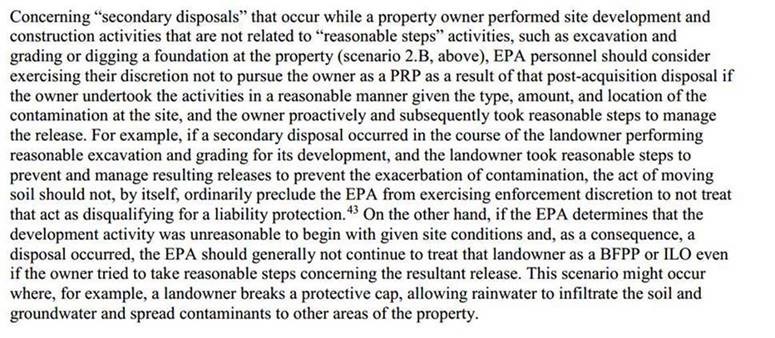EPA Issues Revised Comprehensive Environmental Response, Compensation, and Liability Act (CERCLA) Landowner Defense Guidance
EPA has updated its standard guidance on CERCLA’s landowner defenses for the first time since 2003. The new guidance, issued on July 29, 2019, is titled, “Enforcement Discretion Guidance Regarding Statutory Criteria for Those Who May Qualify as CERCLA Bona Fide Prospective Purchasers, Contiguous Property Owners, or Innocent Landowners,” and it supersedes EPA’s three “interim” CERCLA landowner defense guidance documents that were issued in March 2003. You can access EPA’s new guidance here.
CERCLA’s Draconian Liability Scheme
CERCLA generally imposes strict, joint, several and retroactive liability on certain classes of parties, including current owners and operators of contaminated properties. Prior to the 2002 Brownfields Amendments to CERCLA, this draconian liability scheme led to the underdevelopment of properties impacted by historical releases of hazardous substances for fear that the new owner/developer would become liable for costs to remediate pre-existing contamination (even if a prior owner/operator caused the contamination). The 2002 Brownfields Amendments to CERCLA sought to address this problem by creating three statutory liability defenses for landowners who perform certain pre-closing environmental due diligence (referred to as “all appropriate inquiries”) and comply with continuing obligations post-closing to minimize exposure to the contamination. These three “landowner” defenses are the: (1) bona fide prospective purchaser defense, (2) innocent landowner defense and (3) contiguous property owner defense. Importantly, the bona fide prospective purchaser defense can allow a new property owner to purchase property known to be contaminated without incurring CERCLA liability. In contrast, the innocent landowner and contiguous property owner defenses are only available to new owners/operators who do not identify any historical releases of hazardous substances during the performance of their due diligence.
While the 2002 Brownfields Amendments and EPA’s 2003 “interim” guidance on the three landowner defenses helped usher in a new wave of redevelopment of contaminated properties, they still left several major questions only partially answered. For instance, new owners/operators seeking to maintain a landowner defense are subject to the continuing obligation to not dispose of hazardous substances at the property post-acquisition. Because CERCLA and related case law have liberally interpreted the meaning of “disposal” to establish liability for an incredibly broad range of conduct, the continuing obligation of not “disposing” of hazardous substances could arguably be violated by routine maintenance or construction activities that require excavation in areas with impacted soil/groundwater.
EPA’s New Guidance Provides Clarification on “Continuing Obligations” for Maintaining the CERLCA Landowner Defenses
EPA’s new guidance is designed to clarify when these “continuing obligations” are (or are not) breached, such that CERCLA liability could attach. Key updates and clarifications in EPA’s new guidance include the following:
- More extensive discussion of what types of post-closing actions could constitute “disposal” of hazardous substances such that CERCLA liability could attach to the new owner. EPA’s new guidance draws a distinction for CERCLA liability purposes between “disposal” that is “initial” or “secondary.” With regard to an “initial disposal,” EPA uses the example of a developer bringing new hazardous substances to a site and depositing or discharging them. EPA’s new guidance suggests that “initial disposals” should generally result in CERCLA liability. EPA gave the following two examples for a “secondary disposal”: (1) when an owner/developer takes steps to “manage” existing on-site contamination; and (2) when a property owner redevelops the property, including by grading the site, digging foundations or performing other construction activities. EPA’s new guidance suggests that it may exercise its discretion to not treat a “secondary disposal” as resulting in CERCLA liability, but only if the owner takes “reasonable steps” to manage the resulting release(s).
- Importantly, EPA’s new guidance suggests that a disposal resulting from earthmoving or construction activities should not automatically disqualify the landowner liability defenses if such disposal occurred as a direct result of the new owner taking “reasonable steps.” Below is a relevant excerpt on this issue:

- Clarification that new owners should search government records, property records, historical documents, chain of title documents and land use records as part of their “all appropriate inquiries” to identify and comply with any land use restrictions that apply to the property (this can be accomplished by the environmental consultant performing Phase I/II work).
- Confirmation that new owners should monitor/inspect any institutional controls that are in place specifically to mitigate exposure to contaminants (e.g., concrete caps, other engineering controls) to ensure that they remain effective.
- EPA included new examples of the types of “reasonable steps” that a new owner must take if they discover post-closing that historical releases occurred at the property. Importantly (and consistent with EPA’s prior guidance), such “reasonable steps” do not typically include undertaking actual “remediation” of such contamination.
In This Article
You May Also Like
Navigating California’s Groundbreaking Climate Laws: What Out-of-State Businesses Need to Know EPA Moves to Vacate All Drinking Water Standards for PFAS Other Than PFOA and PFOS